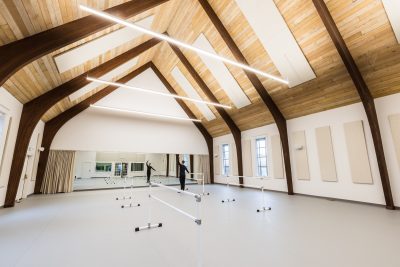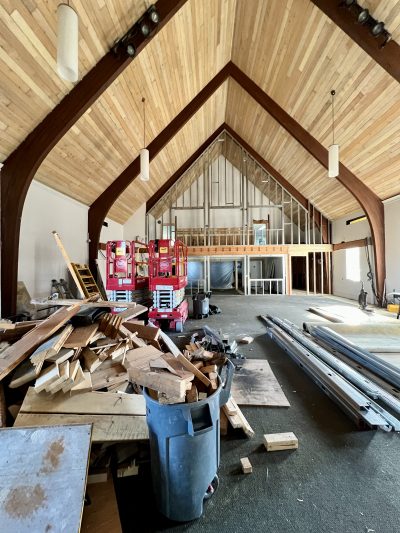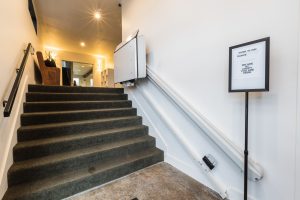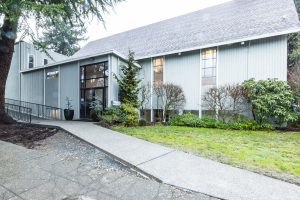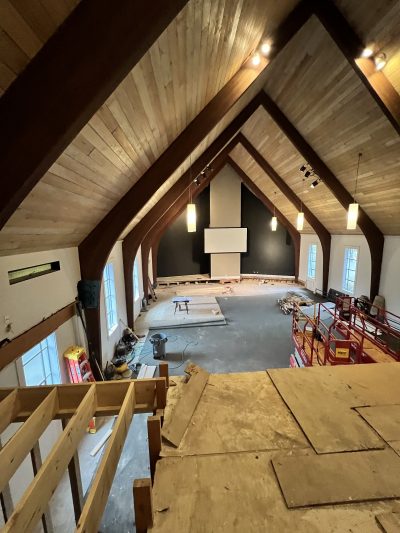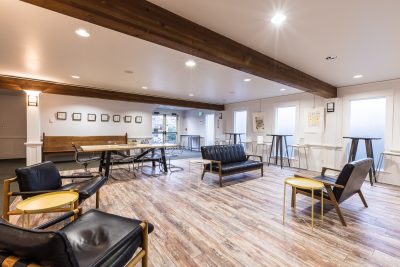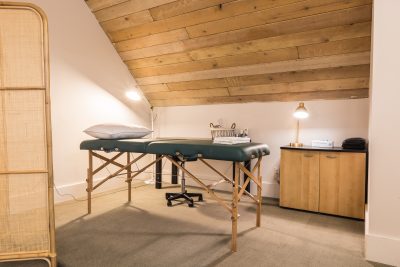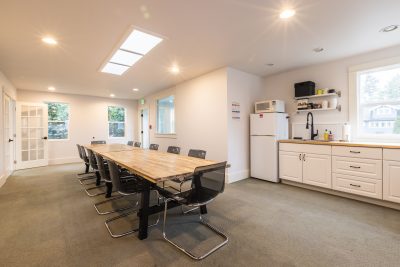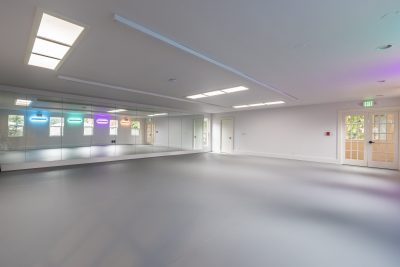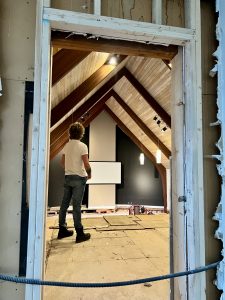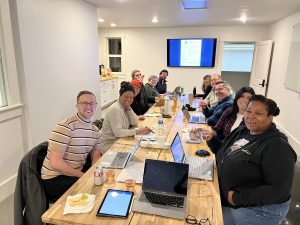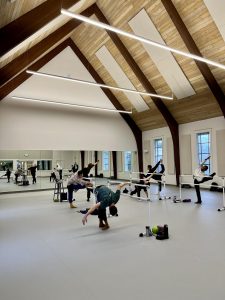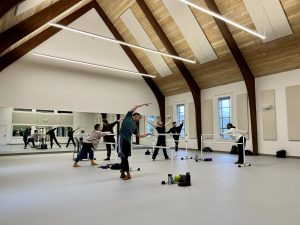Although it can often seem like a mere pipe dream, it’s the long-time wish “of any new company,” as Olivier Wevers Whim W’Him’s founder and Artistic Director says, “to have their own dance center.” But after the pandemic what had seemed to him like a wistful hope for the future became something more like a present necessity. In the time of Covid, where to rehearse and film had been a constant worry for the company.*
Meanwhile, although quite a number of institutions and establishments had sadly suffered financial setbacks, such instability became a factor in more possible places becoming available for purchase. For advice on how to go about securing a viable home for Whim W’Him, Olivier enlisted Paris Sakas, a former board member and founder and president of The Paris Group NW Premium Property Management. When Olivier found a promising site, he would turn to Paris for help in negotiating the long path to occupying the space.
The first property seriously considered, from June 22, 2023, was a church in the Ravenna neighborhood listed at a bit under $3 million. It was nice and in a good location, but there were difficulties. For one thing, it took a bit of insistence even to get to view the property, because, as Olivier says, “Commercial real estate brokers tend not to want to show a place unless the viewer is really ready to buy.”
It also turned out that plenty of potential in this property was matched by plenty of problems.
- An old oil tank would potentially have to be removed. It appeared that a decommissioned oil tank was buried under a garage built on top.
- The place had been perhaps 50% renovated but the other half not, and the building hadn’t been well-maintained.
- There was no on-site parking.
- Although the room was there for two large studios, the main one had a raked or slanted floor that would have to be corrected; other structural issues cropped up as well.
- Finally, because it was in a residential neighborhood, it would need numerous permits from the city.
Coping with all these issues was time-consuming, frustrating, and expensive. It soon became clear too that the costs, beyond purchase price, of putting the building into good shape as a dance center would be significant.
Providentially, an anonymous and enthusiastic patron came onto the scene, offering to lend money for the purchase. Whim W’Him was fortunate also to have the help and vision of Owen Richards, whose company Owen Richards Associates (ORA) designed the Chihuly Garden & Glass, SIFF Film Center and the Volunteer Park Amphitheater.
As there wasn’t much apparent other interest in the property, says Olivier, “We took the time necessary to do the job properly.” Over the course of the next two months, he and these amazing partners, board members and others volunteered many hours toward sorting out mortgages and permits and devising plans for refashioning the building into the spaces needed by a dance company and school.
Then, just as Whim W’Him was getting ready to put in a rather low offer of $2.2 million, they were informed that the church had received a full-price offer. Which of course it accepted. Naturally, to all those who had done so much to ready the Whim offer, its rejection was a huge disappointment.
“But in hindsight,” Olivier now observes, by round two, “we knew a lot more than before and benefited considerably from the experience. Having researched occupancy permits in a residential area for the new center and done all the footwork with the first church, we ended up being a lot more ready for the new space we’re in now.”
Olivier had seen the listing before for a church on Queen Anne Hill. It had been for sale for a while, but at $4.5 million it was clearly too costly. The price had been falling, however, and the property had some assets that would prove essential in the success of the venture.
- The building was in better overall condition than the previous candidate.
- Less structural change was needed.
- There was parking.
Unfortunately, even when the asking price fell to $4 million, it was still out of reach.
But then Olivier and his collaborators made an important discovery. Perhaps the biggest stumbling block to acquiring the first property had been the lack of any way to make supplementary income from it, to help pay the mortgage and for the extensive renovations necessary. The Queen Anne church had three sorts of income already in place:
- A T-Mobile cell tower in the steeple.
- A functioning preschool in the basement.
- A separate 5-bedroom updated parsonage that could be rented to a family.
The possibility of what is legally defined as “passive income” was critical. Olivier prefers to call it “active income.” It certainly was to play an active role in the story of the WWCDC.
The planning stage that followed brought to fruition all the previous thought and work. Owen Richards, the architect, along with the anonymous patron did heroic work to make it affordable. But even when the loaner had agreed to a loan of $3.5 million, an estimated $370,000 in additional funds would still be needed for the necessary renovations.
At this crucial juncture another anonymous donor heard about the project and offered to cover $200,000 of the renovations. The dance company was now in a position to offer $3.5 million. The offer was accepted and the Whim W’Him Contemporary Dance Center was born.
The extra funding was supplemented by a negotiated delay for payback, which altogether gave Whim W’Him the breathing space needed—
- to complete the construction that would dramatically reconfigure the interior of the building to include dance studios, offices, meeting space, a kitchenette, and a dancer lounge with massage-therapy alcove, among other features;
- to start up a school from scratch: planning daily classes (including a free introductory youth/teen class and a $9 first time class for others), workshops, camps, and intensives for dancers of any interest or experience level; hiring teachers (both company members and other respected Seattle teaching artists); and of course working out a school budget;
- to organize providing rental space in the two state-of-the-art studios, as well as subsidized and free studio space;
- to publicize the new Center and do more (renovation costs by now have risen, mostly because of further City permitting requirements, to $520,000);
- to reach out to the neighborhood and the wider community.
Now, rooted in the mission, vision, and values of the company, the Whim W’Him Contemporary Dance Center is well on the way to becoming a safe, supportive, and inclusive environment for individuals to learn and experience the transformative power of dance and for artists to invest in their own creativity.
Olivier has been involved on both macro and micro levels with every aspect, every phase, and every decision throughout the whole process. Observing over time how he has visualized all the spaces of the WWCDC-to-be—their size, function, proportions, and necessary accoutrements—I am reminded of watching him choreograph in the studio. His mind vividly conjures up images—of people, movement, objects, and spaces—whether in a rapidly shifting dance piece or in the slow evolution of a creative nexus to hold his company.
Along with the central figures in this drama of Center creation—Olivier, Paris Sakas, Owen Richards, the anonymous patrons and members of the board—numerous others have contributed to the bringing to life in such a relatively short time of Whim W’Him’s hope for a self-supporting home of its own that can also become a vital part of its community.
No one has been more important to this process than executive Manager Melody O’Neill and Company Manager and Director of Education Karl Watson, the other two legs (besides Olivier) of the tripod that supports Whim W’him. Without these fearless and creative administrators, the project designers, and the financial contributors, bound together by Olivier’s vision, determination, savoir-faire and engagement—and without the seven dancers at the beating heart of the whole enterprise—this dream could never have become reality.
All this vision and behind the scenes work has taken place, of course, in service to Whim W’Him’s core purpose, dancing. The Winter ’24 program came together in the new main studio and finished its run in January 2024 on Vashon Island and at the Cornish Playhouse.
Rehearsals at the Center for the Spring ’24 program are now well underway at the Center for the Spring ’24 program, and the Spring Fling fundraiser is just around the corner:
WHEN: Wednesday, April 10th, 6 – 9:30pm
WHERE: Whim W’Him Contemporary Dance Center
1716 2nd Ave N, Seattle, WA 98109
*The photos in this post were all taken at the new WWCDC on Queen Anne, in roughly chronological order.
